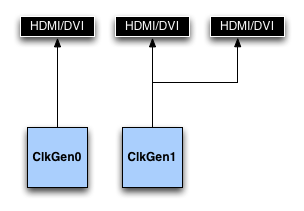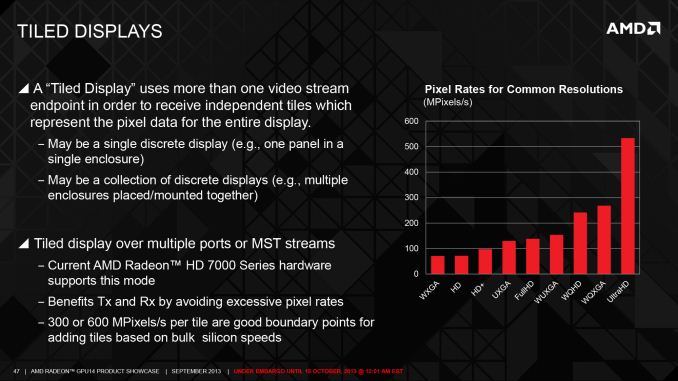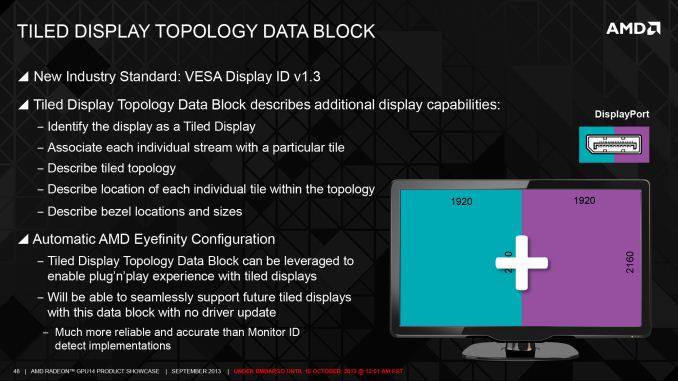The Radeon R9 280X Review: Feat. Asus & XFX - Meet The Radeon 200 Series
by Ryan Smith on October 8, 2013 12:01 AM ESTAMD Display Technologies: 3x DVI/HDMI Out, Tiled Display Support, & More
Although AMD doesn’t have new GPUs to show off today, that doesn’t mean their various hardware groups have been sitting by idle. Even with their existing hardware AMD can make at least some small changes via firmware and drivers, and this is something AMD’s Display Technology group, led by AMD Fellow David Glen, has been working on for the 200 series.
There won’t be any HDMI 2.0 support here (sorry guys, that needs new hardware) but they’ve been working on making improvements to Eyefinity surround setups. As is well known about the 7000 series, it was limited to 2 independent TMDS interface (DVI/HDMI) displays at once. Unlike the packet based DisplayPort interface, which operates at a single clockspeed and can vary the number of packets sent to adjust the resulting bandwidth, TMDS style interfaces adjust the clockspeed of the interface itself to match the needs of the display. As a result while you can drive a large number of DisplayPort interface monitors off of a single shared clock generator, you need a dedicated clock generator for each and every TMDS interface monitor. AMD only put 2 clock generators for TMDS interfaces on their silicon, hence they could only drive 2 such monitors at once.

Radeon 7000 Series DVI/HDMI Output Options: 3, Choose 2
With the 200 series this isn’t changing – it’s the same silicon after all – but AMD has implemented some new tricks to partially mitigate the issue. Thanks to some firmware and board level changes, with the 200 series AMD is now able to attach multiple TMDS transmitters/interfaces to the same clock generator, allowing one clock generator to be used to drive multiple displays. As a result it’s now possible to drive up to 3 TMDS interface displays off of a single 200 series card, albeit with restrictions.
The catch here is that these can’t be independent displays, and this change is primarily intended towards enabling Eyefinity with cheap, DVI/HDMI-only monitors. To utilize clock sharing and to drive 3 such monitors off of a single card, all 3 monitors must be timing-identical, which functionally speaking almost always requires the monitors to be completely identical. Furthermore the sharing of the clock generator can only be engaged/disabled upon boot, so the 3rd display cannot be hot-plugged and must be present at boot time. Consequently this is by no means as unrestricted and easy as having native support for 3 TMDS interface displays, but for Eyefinity it will get the job done.

Radeon 200 Series DVI/HDMI Output Options: All 3 Together, As Long As They're Identical
Of course this restriction only applies to using 3 TMDS interface monitors off of a single card natively. Using the DisplayPort, either with a native monitor or through an active DP-to-DVI/HDMI adapter, still allows the same fully independent functionality as before.
Moving on to something a bit more applicable to all Radeon users, as our regular readers are aware AMD is a significant participant in the VESA standards body, the group responsible for the DisplayPort standard. As part of the general trend in consumer electronics, the VESA group has been gearing up for 4K “UltraHD” displays, including rolling out updates for their various standards to better manage the emergence of those displays.
AMD, vis-à-vis the VESA, is rolling out support for VESA Display ID 1.3 in their newest drivers, for availability in the Radeon HD 7000 series and above. Display ID 1.3’s significant addition is that it formalizes support for so-called tiled displays, which implement very high resolutions such as 4K in the form of multiple lower resolution tiles that identify and behave like separate monitors. Tiled displays are atypical for PC displays, which are historically based on a single tile/stream, and for the immediate purposes of the PC industry are something of a half-way house for 4K @ 60Hz on the PC, as timing controllers for monitors to do 4K @ 60Hz natively simply do not exist yet. This is why monitors such as the recently released Asus PQ321 utilize tiles.
Ultimately tiled 4K displays are a transitionary technology as they’ll be replaced with native (single tile) 4K displays next year when suitable timing controllers hit the market, but in the interim Display ID 1.3 is the formal solution to that problem, along with allowing the VESA to lay the groundwork for future, even larger tiled displays.
To this end, Display ID 1.3 implements support for tiled monitors by adding a new data block to the descriptor, the Tiled Display Topology Data Block. The TDTDB is used by displays and other sink devices to tell source devices about the existence of the tiles, the format/resolutions they use, and the relative positioning of the tiles. Coupled with DisplayPort 1.2, which can carry multiple display streams over a single connector via MST technology, and it’s possible to hook up a tiled 4K display via a single DisplayPort connection, with Display ID providing the necessary data for the video card to make it seamlessly work.
Looking towards the future, AMD has also explicitly mentioned plans for supporting native 4K @ 60Hz monitors in the future, once the necessary timing controllers become available. Curiously only the R9 290 series is mentioned as supporting this mode (note that it’s based on new silicon), but as we’re a year out we’ll see how that goes when the time comes.
Finally, as another improvement coming to the 200 series, AMD’s Discrete Digital Multipoint Audio (DDMA) support is getting an upgrade. First introduced alongside the 7000 series, DDMA allows for audio-capable HDMI/DisplayPort monitors to coexist, and for each to present themselves as an independent sound sink. The idea behind this technology is to enable uses where having discrete speakers dedicated to each monitor would come in handy, such as video conferencing.
However utilizing DDMA as it originally shipped required software to support sending audio to multiple independent devices at once. Some software supported this and some did not. So as a driver level tweak AMD is implementing an alternative mode where the driver presents a 6 channel setup as a single sink, and then splits up those channels among the actual monitors. The use cases are a bit more limited here – AMD proposes using it for TrueAudio even though no one is going to be positioning a monitor behind themselves – but it’s a simple hack that none the less allows using the speakers from additional monitors in additional cases where the application itself doesn’t natively support it.



















151 Comments
View All Comments
alfredska - Wednesday, October 9, 2013 - link
Yes, I made a couple mistakes in trimming the fat from Ryan's writing. I should have done another proof-read myself. This wasn't the point of my post, though.Ryan's review is littered with sentence pauses that drastically slow down your ability to read the article. Some examples are: starting too many sentences with words like "ultimately" or "meanwhile"; making needless references to earlier statements; using past or present perfect tense when just past or present tense is appropriate. I wrote the above example hoping that Ryan would put it next to his own writing and see whether he can 1) read it faster, and 2) retain more information from this version.
I can accept a misspelling here and there and even some accidental word injections of which I was guilty. The fluidity needs work though. If the reader cannot glide easily between paragraphs, they will stop reading and just look at pictures.
chuck.norris.and.son - Tuesday, October 8, 2013 - link
tl:dr :( blablablaCan't you nail it down: AMD or Nvidia? Which GFX card should i buy to play Blockbuster like BF 4?
ShieTar - Tuesday, October 8, 2013 - link
How about not buying any new GFX card and investing the savings into books in order to improve your reading skills?Will Robinson - Tuesday, October 8, 2013 - link
Radeon 280X will be the sweet spot card to get for BF4.R9 290X will be the open class champ over GTX780 I suspect.
piroroadkill - Tuesday, October 8, 2013 - link
The best AMD card you can buy with your money, simply because Battlefield 4 will eventually feature the Mantle renderer which is for GCN cards only, and will probably be a killer feature.hrga - Tuesday, October 8, 2013 - link
Most moronic branding ever (at least the one to be overrun). They cutout vanilla 7850 or top end 7950 from the HD7000 lineup and call it with confusing R9/R7, unrealistically stupid marketing where nothing material stand behind those names.Another rebranding?
- Yes. [thinking. What the heck did you expect guys]
Not most successful?
- [thinking. depends on POV] Well, it's here to milk the most cash as our CPU business didnt produced anything valuable for three years. And we also must have something interesting to present in our slideshow presentation for investors. If we couldn't afford to produce whole new lineup we could always produce yet another rebranded line just like nvidia. We always learn from our (cartel) competition, and customers don't seem to have any objections on that matter.
So that's why you retain those moronically high prices?
- We just adjust that according to our competition (cartel)
But you never lower prices for HD7870 which today celebrates its second birthday and is produced on highly matured 28nm for at least six month. Instead you just rebranded it for second time after HD8860, so now we have R9 270X too. Don't you think you're customers would like to see some new designs while putting old products on discount prices?
Or at least you could introduce that R9 270, which is same old HD7870, with lower prices than todays HD7870 retail prices are?!
Instead of higher up prices for same performance (source Newgg http://imageshack.dk/imagesfree/xLh43741.jpg).
And why the heck R9 desination for this mediocre mainstream product?! You could weaselishly sell this c-rap at the end of 2011, but "Hello AMD!" It the end of 2013.
Pitcairn used in HD7800/HD8800 seriesis is smaller chip than Evergreen in HD5800, which only three years ago was produced on troublesome early 40nm process while this is two year old design now produced on highly mature TSMC 28nm-HK node for at least six month with far better yields? HD5850 had same or even lower prices at EOL (only year after introduction) than todays two year old Pitcairn desing. How do you explain that?
- Well ...Milking you know ... When you have good cartel environment like we have competing with nvidia we could sky rocket prices. And you know even crappy Intels Knights Corner chips today produced at 22nm would be any cheaper because Intel knows how to milk moneys on their tick-tock performance introductions and they certainly would gave up that experience in case of "Chip Previously Known as Larabee" (CPKL)
labodhibo - Tuesday, October 8, 2013 - link
Must read this.. totally different perspective:http://www.techspot.com/review/722-radeon-r9-270x-...
AssBall - Tuesday, October 8, 2013 - link
Well done review. I kinda like what Asus did with its 280x version.Typo: "Asus calls it “CoolTech” and it’s essentially an effort to build a fan that’s blow a an axial fan and a blower (radial) fan at the same time,"
[blow -> both?]
zlandar - Tuesday, October 8, 2013 - link
This is why I wanted the Asus 770 card also in the recent 770 GTX roundup. The cooler design seems superior for single GPU purposes as long as you have the room for it in your case.AxialLP7 - Tuesday, October 8, 2013 - link
Not trying to be AFC, just want to make sense of this: "Asus calls it “CoolTech” and it’s essentially an effort to build a fan that’s blow a an axial fan and a blower (radial) fan at the same time, explaining the radial-like center and axial-like outer edge of the fan." Can someone help? This is in the "ASUS RADEON R9 280X DIRECTCU II TOP" section...